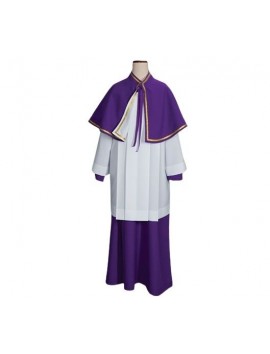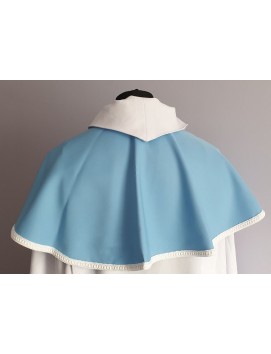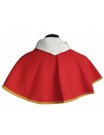No products
Altar Servers
Altar servers are lay assistants to members of the clergy during Christian liturgies. They assist the priest and deacon during the Eucharist and other liturgical ceremonies so that the liturgy can be conducted with grace and reverence. Altar servers attend to supporting tasks at the altar such as fetching and carrying, ringing the altar bell, helping bring up the gifts, and bringing up the liturgical books, among other things. Altar servers can be of any age or gender, and in some Christian denominations, they are known as acolytes. Altar servers are expected to be active and full participants in the celebration, singing, praying, and keeping silence along with the rest of the assembly.
Altar servers are lay assistants to members of the clergy during Christian liturgies. They assist the priest and deacon during the Eucharist and other liturgical ceremonies so that the liturgy can be conducted with grace and reverence. Altar servers attend to supporting tasks at the altar such as fetching and carrying, ringing the altar bell, helping bring up the gifts, and bringing up the liturgical books, among other things. Altar servers can be of any age or gender, and in some Christian denominations, they are known as acolytes. Altar servers are expected to be active and full participants in the celebration, singing, praying, and keeping silence along with the rest of the assembly.
Subcategories
-
Altar shoulder capes
Altar shoulder capes are a type of liturgical garment worn by members of the clergy during Christian liturgies. They are short capes that are open in front and reach to the elbow. Altar shoulder capes are available in all liturgical colors, including white, green, red, purple, light blue, and gold. They are often trimmed with gold piping or decorative tape. Altar shoulder capes are used by the clergy, including the Pope, cardinals, bishops, and altar servers. They are a luxurious and unique garment that is expertly crafted for those seeking the height of style. Altar shoulder capes are fastened with a hook and eye fastener and are available in universal sizes
-
Cintures
Cintures are liturgical belts or thick ropes with tassels at both ends, used by clergy and ministers in Christian churches as part of a liturgical vestment. They are available in various materials, including cotton, rayon, and cord, and in all liturgical colors, including red, purple, green, blue, gold, and white. Cintures are used to cinch the alb, the white robe worn by the clergy, at the waist. They are also used to fasten the stole, a long, narrow strip of cloth worn by the clergy over the alb. Cintures are available in different lengths, ranging from 72 inches to 144 inches, and are finished with a small tassel on each end. They are an essential part of the liturgical vestment and are worn by priests, deacons, acolytes, and altar servers.
-
Altar server alb
An altar server alb is a type of garment worn by altar servers during liturgical services in the Catholic Church. It is a long, white robe that covers the server's clothing and is typically made of wash-and-wear fabrics that are crease-resistant. The alb is a liturgical vestment that is proper to bishops, priests, deacons, acolytes, and lectors, but not to servers, readers, cantors, and the like, according to the Universal Church. The alb is a symbol of purity and is worn to signify the server's role in assisting the priest during the Mass. Altar server albs are available in various sizes and styles, including those for children and adults
-
Altar server surplice
An altar server surplice is a liturgical vestment worn by altar servers during Mass in the Catholic Church. It is a white, lightweight, and loose-fitting garment that is worn over the server's clothing and reaches down to the knees. Altar server surplices are typically made of cotton, viscose, polyester, or lace. The surplice is a symbol of purity and is worn to signify the server's role in assisting the priest during the Mass. Altar server surplices are available in various sizes and styles, including pleated and square neck designs
-
Altar server cassocks
An altar server cassock is a type of liturgical vestment worn by altar servers during Mass in the Catholic Church. It is a long, ankle-length garment that is typically black, white, red, or purple. Altar server cassocks are usually made of polyester and cotton blends that are easy to care for and have heavy-duty snaps. Altar server cassocks are available in various sizes and styles, including full-cut and unisex designs. Altar server cassocks are worn over the server's clothing and are a symbol of the server's role in assisting the priest during the Mass.
-
Altar server skirt
Altar server skirt is a great choice for any occasion. Made from a lightweight, stretchy fabric with a strong elastic waistband, this skirt is both comfortable and easy to maintain. This product also offers superior quality and is available in five colors: white, black, red, purple, and green. Ideal for any service or event where you need to look your best!
-
Altar server cloak white one-sided Altar server cloak white one-sided
Altar server cloak white one-sided Altar server cloak white...
$ 24
Altar Servers: The Heartbeat of Liturgical Celebrations
Altar servers hold a special place in the heart of liturgical celebrations, demonstrating piety and decorum to the congregation. Their role, deeply rooted in the ancient traditions of the church and piety, is both a privilege and a responsibility. It's a role that transcends age, gender, and background, uniting individuals in their shared service to the altar, god, and the community. This comprehensive guide dives into the world of altar servers, shedding light on their duties, significance, functions, piety, and the profound impact they have on the liturgical life of the church.
The Role and Responsibilities of Altar Servers
Altar servers are the silent, yet pivotal figures in liturgical celebrations. They assist the priest, god, and deacon as altar servers during the Eucharist and other liturgical ceremonies at the altar table, ensuring that the liturgy is conducted with grace and reverence. Their duties as altar servers are varied and vital, from carrying the cross and processional candles to assisting with the preparation of the gifts and the washing of hands. In the absence of a sacristan, they may also prepare the altar and sacred vessels before Mass.
The Significance of Altar Serving
Serving at the altar as a server is more than just fulfilling a set of tasks; it's a ministry that fosters a deeper understanding and appreciation of the liturgy. It's an opportunity for personal and spiritual growth, allowing servers to develop a closer relationship with God and their community. This ministry has historically been a source of vocations to the priesthood and religious life, highlighting its importance in nurturing future church leaders.
Training and Formation
Becoming an altar server requires proper preparation and commitment. Candidates must be baptized and have received the Eucharist, with confirmation being encouraged but not mandatory. Training programs are essential for equipping servers with the knowledge and skills needed to perform their duties effectively. These programs cover everything from the structure of the Mass and the significance of its parts to the practical aspects of serving at the altar.
The Inclusivity of Altar Serving
The ministry of altar serving is inclusive, welcoming both male and female servers. This openness reflects the church's recognition of the valuable contributions that all members, server, of the community can make to liturgical celebrations. The decision to include female servers is made at the diocesan level, ensuring a uniform policy that respects the diversity of the church.
The Impact of Altar Servers on Liturgical Celebrations
Altar servers play a crucial role in enhancing the solemnity and reverence of liturgical celebrations. Their presence at the altar and participation as a server help to create a prayerful atmosphere that encourages the congregation to engage more fully in the worship experience. By performing their duties with dedication and reverence, altar servers set an example for the assembly, inspiring others to deepen their own participation in the liturgy.
Conclusion
Altar servers are indispensable to the liturgical life of the church. Through their service as server, they not only assist the clergy at the altar and contribute to the beauty of the liturgy but also embark on a journey of personal and spiritual growth. Their ministry is a testament to the power of serving others and the transformative impact it can have on their lives and the lives of those around them. As the church continues to evolve, the ministry of altar serving remains a vital and cherished tradition, embodying the spirit of service and community at the heart of Christian worship.










































